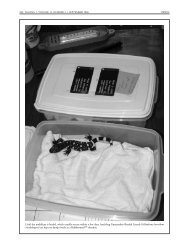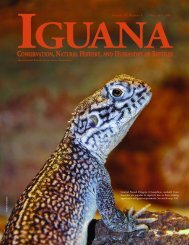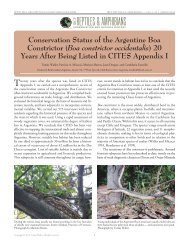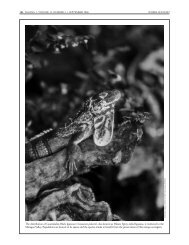Spiny-tailed Iguanas (Ctenosaura similis) in Venezuela
Spiny-tailed Iguanas (Ctenosaura similis) in Venezuela
Spiny-tailed Iguanas (Ctenosaura similis) in Venezuela
You also want an ePaper? Increase the reach of your titles
YUMPU automatically turns print PDFs into web optimized ePapers that Google loves.
Lesser Antillean Iguana (Iguana delicatissima) are almost exclusively herbivorous (the yellow color on the iguana’s face is from eat<strong>in</strong>g mangos) and largely arboreal,<br />
descend<strong>in</strong>g to the ground to forage or defend territories for only short periods each day. Dom<strong>in</strong>ican Ground Lizards (Ameiva fuscata) are almost entirely<br />
terrestrial and are opportunistic foragers that feed mostly on small <strong>in</strong>vertebrates, but will eat fruits when available. These two <strong>in</strong>dividuals came <strong>in</strong>to close proximity<br />
to bask <strong>in</strong> a small patch of sunlight. See article on p. 130.<br />
Mart<strong>in</strong>ique Frogs (Eleutherodactylus mart<strong>in</strong><strong>in</strong>censis) are ubiquitous on Dom<strong>in</strong>ica. This <strong>in</strong>dividual has an unusually dist<strong>in</strong>ct middorsal “rac<strong>in</strong>g” stripe, a pattern<br />
element sometimes seen <strong>in</strong> the Dom<strong>in</strong>ican Frog (E. ampl<strong>in</strong>ympha), which is restricted to higher elevations on the island. See article on p. 130.<br />
JEFFREY W. ACKLEY<br />
ROBERT POWELL








